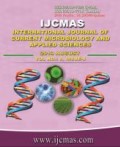


 National Academy of Agricultural Sciences (NAAS)
National Academy of Agricultural Sciences (NAAS)

|
PRINT ISSN : 2319-7692
Online ISSN : 2319-7706 Issues : 12 per year Publisher : Excellent Publishers Email : editorijcmas@gmail.com / submit@ijcmas.com Editor-in-chief: Dr.M.Prakash Index Copernicus ICV 2018: 95.39 NAAS RATING 2020: 5.38 |
The present study was conducted to know the selective breeding, feeding and management practices followed by dairy farmers in Punjab. A total of 150 farmers were selected randomly and divided into three categories, small (n=48), medium (n=74) and large (n=28). With help of well-structured interview schedule and pretested questionnaire data were collected w.r.t. breeding, feeding and management practices being followed. The data revealed that the farmers offered 20-40 kg of green fodder and 2-5 kg of concentrate mixture to dairy animals, but only 23.3 per cent of farmers used mineral mixture regularly. Majority (86.91%) of the farmers had adopted artificial insemination for cows but percentage was quite low (21.08%) in buffaloes. Calf mortality was 22.67 per cent in male calves against 2.67 per cent in female calves. About 49.3 per cent farmers were selling their through middleman as compared to 22.67 per cent and 2 per cent through cooperative societies and self-marketing, respectively. The incidence of reproductive disorders like anoestrus (13.33%), repeat breeding (19.33%), metritis (8%) and retention of placenta (2%) were high whereas prevalence of mastitis was observed in 17.33 per cent herds in the area under study. Therefore, study revealed that there is a dire need to educate dairy farmers about feeding, breeding and management practices through better extension contacts, mass campaigns, training as well as mass media in order to sustainable and profitable running of dairy farming in Punjab.
 |
 |
 |
 |
 |